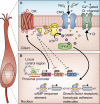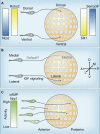The cell biology of smell
- PMID: 21041441
- PMCID: PMC3003330
- DOI: 10.1083/jcb.201008163
The cell biology of smell
Abstract
The olfactory system detects and discriminates myriad chemical structures across a wide range of concentrations. To meet this task, the system utilizes a large family of G protein-coupled receptors-the odorant receptors-which are the chemical sensors underlying the perception of smell. Interestingly, the odorant receptors are also involved in a number of developmental decisions, including the regulation of their own expression and the patterning of the olfactory sensory neurons' synaptic connections in the brain. This review will focus on the diverse roles of the odorant receptor in the function and development of the olfactory system.
Figures




References
Publication types
MeSH terms
Substances
Grants and funding
LinkOut - more resources
Full Text Sources
Other Literature Sources

